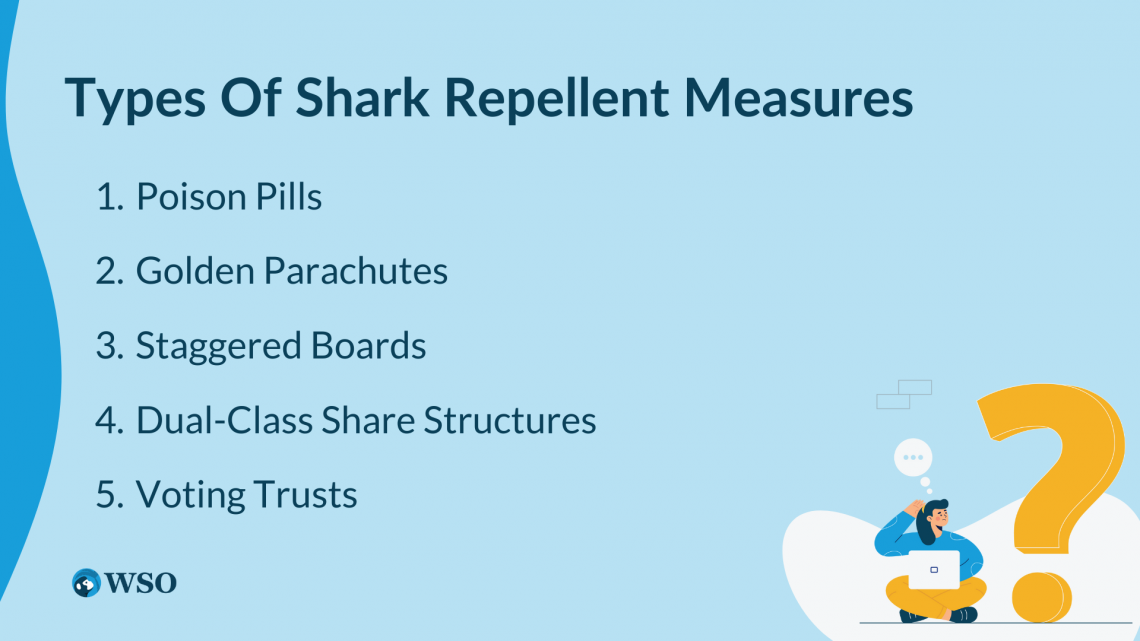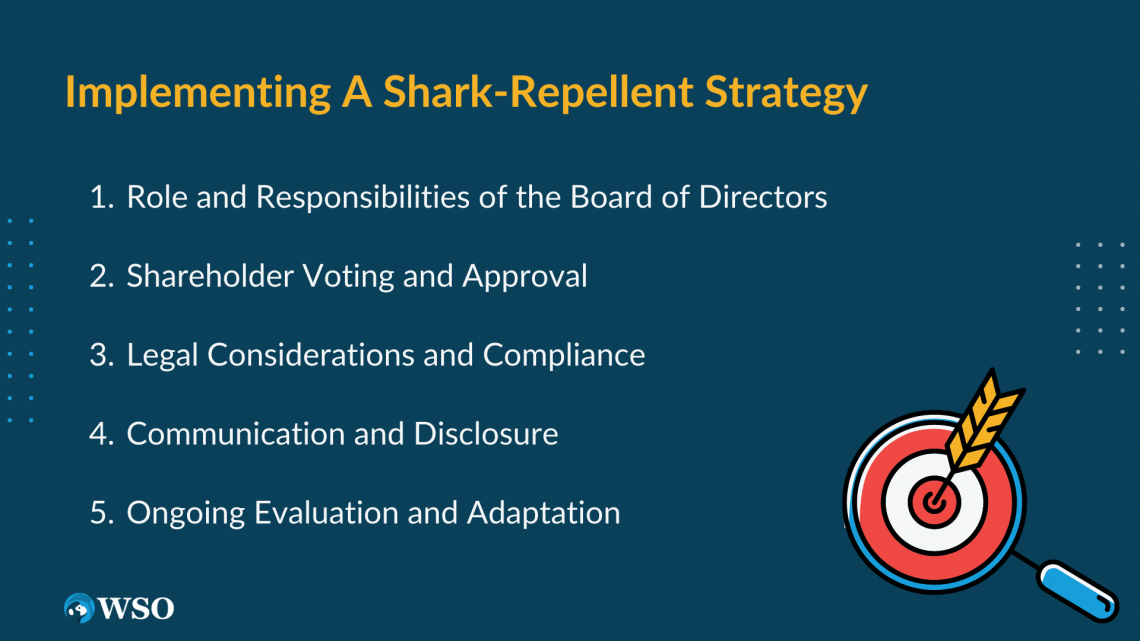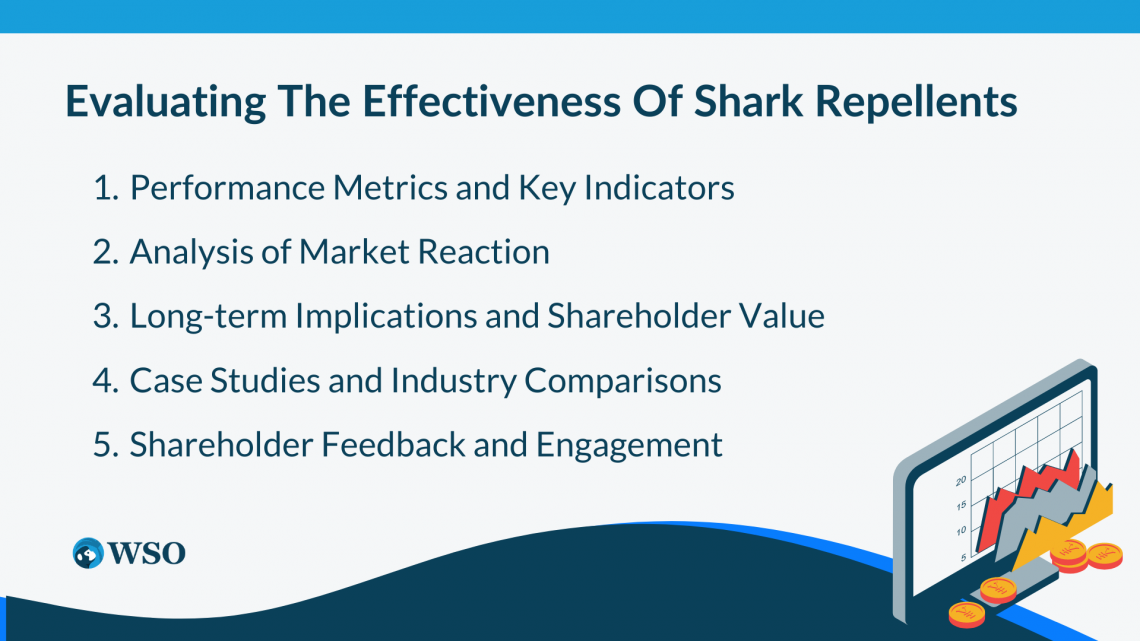Shark Repellent
These strategies are defensive measures used by companies to deter hostile takeovers and protect their interests.
In the corporate world, hostile takeovers can create a sense of vulnerability and uncertainty for companies and their stakeholders.

These takeovers occur when an external entity, commonly known as a "shark," seeks to acquire a significant controlling stake in a target company without the approval or agreement of its management and board of directors.
Companies may employ various defensive measures known as shark-repellent takeover strategies to counter such threats.
Shark-repellent takeover strategies are designed to deter hostile takeover attempts, protect the interests of existing management, and ensure the continuity of the company's operations.
These strategies encompass a range of defensive measures that make it less attractive or more challenging for a potential acquirer to gain control of the target company.
The primary objective of shark-repellent measures is to grant the target company’s management ample time and leverage to negotiate for improved terms or explore alternative options that align with the company's and its shareholders' best interests.
These strategies aim to increase the costs and risks associated with a hostile takeover by introducing hurdles and deterrents, dissuading potential acquirers from pursuing their aggressive intentions.

Common types of shark-repellent measures include poison pills, golden parachutes, staggered boards, dual-class share structures, and voting trusts.
Poison pills, for instance, grant existing shareholders the right to acquire additional shares at a discounted price, diluting the acquirer's stake and making the takeover financially less attractive.
On the other hand, Golden parachutes provide lucrative compensation packages for executives in the event of a change in control, making it expensive for acquirers to remove key management personnel.
Implementing shark-repellent measures requires careful consideration of legal and regulatory requirements and effective communication with shareholders.
The board of directors assumes a crucial role in assessing and endorsing these defensive mechanisms, guaranteeing their alignment with the company's long-term objectives and the best interests of its shareholders.

Evaluating the effectiveness of shark-repellent measures involves assessing their impact on shareholder value, market reaction, and the ability to thwart hostile takeover attempts.
Performance metrics and key indicators can help gauge the success of these strategies and guide future decision-making.
Case studies analyzing real-world examples of successful shark-repellent strategies can provide further insight.
These case studies highlight the practical application of various defensive measures, such as poison pill implementation, golden parachute adoption, staggered board implementation, dual-class share structures, and the utilization of voting trusts.
Key Takeaways
- Hostile takeovers threaten companies and their stakeholders, prompting the implementation of shark-repellent strategies.
- Shark-repellent measures aim to deter hostile takeover attempts, protect management's interests, and ensure business continuity.
- Common shark-repellent measures include poison pills, golden parachutes, staggered boards, dual-class share structures, and voting trusts.
- Implementing shark-repellent strategies requires careful consideration of legal and regulatory requirements, effective communication with shareholders, and endorsement by the board of directors.
- Evaluating the effectiveness of shark-repellent measures involves assessing their impact on shareholder value, market reactions, and the ability to thwart hostile takeover attempts. Case studies of successful strategies offer valuable insights into the practical application of these measures.
Types of Shark Repellent Measures
In the high-stakes world of corporate takeovers, companies employ various defensive strategies, commonly called "shark-repellent measures," to ward off hostile acquisition attempts and protect their interests.

These measures are designed to create obstacles and deterrents that make it challenging for acquirers to gain control or make the takeover financially unattractive. Here are some of the key types of shark-repellent measures:
1. Poison Pills
These are widely used defense tactics. They are provisions incorporated into a company's bylaws that trigger certain unfavorable consequences in the event of a hostile takeover.
NOTE
One common type is the "flip-in" poison pill, which allows existing shareholders to purchase additional shares at a discounted price, diluting the acquiring company's stake and making the takeover more expensive.
2. Golden Parachutes
These contractual agreements offered to key executives provide substantial financial benefits if a change of control occurs.
These agreements aim to ensure that executives are financially protected and also serve as a deterrent to potential acquirers who may be unwilling to bear the additional costs associated with compensating executives.
3. Staggered Boards
Also known as classified boards, staggered boards divide a company's board of directors into multiple classes, with each class serving staggered terms. This prevents a hostile acquirer from gaining immediate control of the entire board, as they would need to win multiple elections over time.
NOTE
Staggered boards can buy valuable time for the target company to assess takeover proposals and explore alternatives.
4. Dual-Class Share Structures
Dual-class share structures involve issuing different classes of shares with distinct voting rights. Typically, the founders or key stakeholders hold shares with superior voting rights, allowing them to maintain control over the company even if their ownership stake diminishes.
This structure acts as a deterrent to hostile takeovers by consolidating voting power in the hands of a select group.
5. Voting Trusts
This consolidates the voting rights of a group of shareholders into a trust, which assumes the responsibility of exercising those rights on their behalf.
Through this consolidation of voting power, shareholders can collectively defend against hostile takeovers or enhance their bargaining position to negotiate more favorable terms.
NOTE
These types of shark-repellent measures provide companies with strategic options to protect themselves against hostile takeovers, maintain independence, and safeguard the long-term interests of shareholders.
Implementing A Shark-Repellent Strategy
Implementing shark-repellent measures requires careful planning, strategic decision-making, and coordination among key stakeholders of a target company.

The successful implementation of these defensive strategies is crucial to safeguarding company interests and deterring hostile takeover attempts. Here are key considerations for implementing shark-repellent measures:
1. Role and Responsibilities of the Board of Directors
They assume a central role in evaluating, approving, and overseeing shark-repellent measures.
They ensure these measures align with the company's long-term goals and shareholder interests. Before making informed decisions, the board should thoroughly assess each strategy's potential impact, risks, and benefits.
2. Shareholder Voting and Approval
Certain shark-repellent measures may require shareholder approval depending on the jurisdiction and company bylaws.
NOTE
Companies need to communicate effectively with shareholders, presenting the rationale and benefits of the proposed measures to secure their support. Timely and transparent disclosure is essential to maintain shareholder trust and facilitate smooth implementation.
3. Legal Considerations and Compliance
Implementing shark-repellent measures necessitates compliance with relevant laws, regulations, and corporate governance standards.
Engaging legal counsel and ensuring that the chosen strategies are legally sound and compliant with the jurisdiction's requirements is crucial. This includes assessing the legality of poison pills, golden parachutes, staggered boards, and other measures based on local corporate laws.
4. Communication and Disclosure
Clear communication with internal and external stakeholders is vital during the implementation process. The target company should proactively communicate the chosen shark-repellent measures' purpose, benefits, and implications.
NOTE
Transparent disclosure ensures that shareholders, employees, and other stakeholders understand the defensive strategies being employed and can align their expectations accordingly.
5. Ongoing Evaluation and Adaptation
Shark-repellent measures should be regularly evaluated to assess their effectiveness and adapt to changing circumstances.
The board should continuously monitor market conditions, shareholder sentiment, and any potential loopholes that acquirers could exploit.
This ongoing evaluation enables the company to make necessary adjustments or consider alternative measures if needed.
NOTE
Implementing shark-repellent measures requires a strategic and proactive approach that safeguards the company's interests while upholding sound corporate governance principles.
By involving the board of directors, obtaining shareholder approval when necessary, ensuring legal compliance, maintaining transparent communication, and continuously evaluating their effectiveness, companies can strengthen their defenses against hostile takeovers.
Evaluating The Effectiveness Of Shark Repellents
Evaluating the effectiveness of shark-repellent measures is crucial to determine their impact on the target company's ability to fend off hostile takeover attempts and protect the interests of its shareholders.

By analyzing key performance metrics, market reactions, and long-term implications, companies can assess the success of their defensive strategies. Here are some considerations when evaluating the effectiveness of shark-repellent measures:
1. Performance Metrics and Key Indicators
Companies should establish performance metrics and key indicators to gauge the effectiveness of their shark-repellent measures. These metrics can include stock price performance, shareholder returns, market capitalization, and financial ratios.
By comparing pre- and post-implementation data, companies can assess whether the measures have achieved their intended outcomes, such as preserving shareholder value or minimizing disruption.
2. Analysis of Market Reaction
The market's reaction to implementing shark-repellent measures provides valuable insights into their effectiveness.
NOTE
Monitoring stock price movements, trading volume, and analyst reports can help assess investor sentiment and perceptions of the company's defensive strategies.
Positive market reactions, such as increased stock prices or improved investor confidence, may indicate that the measures have successfully bolstered shareholder confidence and deterred potential acquirers.
3. Long-term Implications and Shareholder Value
Evaluating the long-term implications of shark-repellent measures is essential. In evaluating shark-repellent measures, companies must prioritize assessing their impact on long-term shareholder value.
NOTE
When conducting the assessment, companies analyze factors such as corporate governance practices, strategic decision-making, and their ability to attract and retain investors.
By examining these aspects, companies can gain valuable insights into the overall effectiveness of the measures implemented.
4. Case Studies and Industry Comparisons
Analyzing case studies of companies that have successfully implemented shark-repellent measures can provide valuable lessons and benchmarks for evaluation.
By studying similar industry peers and their experiences with defensive strategies, companies can gain insights into the potential effectiveness of different approaches. These case studies can inform decision-making and help refine existing measures.
5. Shareholder Feedback and Engagement
Companies should actively seek shareholder feedback regarding their perception and satisfaction with the implemented shark-repellent measures.
Conducting surveys, engaging in shareholder dialogue, and monitoring proxy voting results can provide valuable insights into shareholder sentiment and the effectiveness of the measures in protecting their interests.
Regularly evaluating shark-repellent measures ensures companies adapt their strategies to changing market dynamics and potential vulnerabilities. It also allows for adjustments or the exploration of alternative measures if needed.
NOTE
Effective evaluation provides valuable feedback for the board of directors to enhance and refine their defensive strategies continuously, safeguarding the company's and its shareholders' long-term interests.
Case Studies Of Successful Shark Repellent Strategies
Examining case studies of companies that have implemented successful shark-repellent strategies provides valuable insights into the effectiveness of these defensive measures and their impact on the target company's ability to ward off hostile takeover attempts.

Here are a few notable examples:
1. Google (Alphabet Inc.)
In 2014, Google implemented a dual-class share structure, creating two classes of shares with different voting rights.
This allowed the founders, Larry Page and Sergey Brin, to control key decisions even though their ownership stake was reduced.
This structure has helped protect Google's long-term vision and independence from potential acquirers seeking to exert influence over the company
2. Airgas
In 2010, Airgas, a leading supplier of industrial, medical, and specialty gases, successfully defended against a hostile takeover attempt by Air Products and Chemicals.
Airgas implemented a poison pill provision that allowed shareholders to purchase additional shares at a discount, diluting the acquiring company's stake.
NOTE
The defensive measure and a staggered board structure gave Airgas time to explore alternatives and negotiate a higher offer. This led to a successful defense against the hostile takeover bid.
3. The Hershey Company
In 2002, The Hershey Company, a well-known chocolate manufacturer, implemented a trust structure to safeguard its independence.
The trust holds a significant portion of Hershey's voting shares, ensuring that decisions regarding the company's future remain aligned with its mission and values.
NOTE
This trust structure played a pivotal role in fending off a potential acquisition by a larger multinational company. It also preserved Hershey's identity as a distinct and independent organization.
4. Yahoo!
In 2008, Yahoo! adopted a shareholder rights plan, commonly known as a poison pill, to defend against a hostile takeover attempt by Microsoft.
The poison pill provision was triggered when an acquirer attempted to acquire more than 15% of Yahoo!'s shares. This defensive strategy gave Yahoo! time to explore strategic alternatives and eventually negotiate a more favorable deal with Microsoft.
5. Facebook
In 2016, Facebook implemented a unique share structure that allowed founder Mark Zuckerberg to retain control even as the company went public.
The dual-class share structure granted Zuckerberg and other Class B shareholders enhanced voting rights, providing a strong defense against potential takeovers and ensuring the company could stay focused on its long-term vision.
These case studies highlight the importance of implementing strategic shark-repellent measures and their effectiveness in protecting companies from hostile takeovers.
By deploying measures such as dual-class share structures, poison pills, trust structures, and other defensive strategies, these companies have successfully defended their independence, preserved their strategic direction, and safeguarded the interests of their shareholders.




or Want to Sign up with your social account?